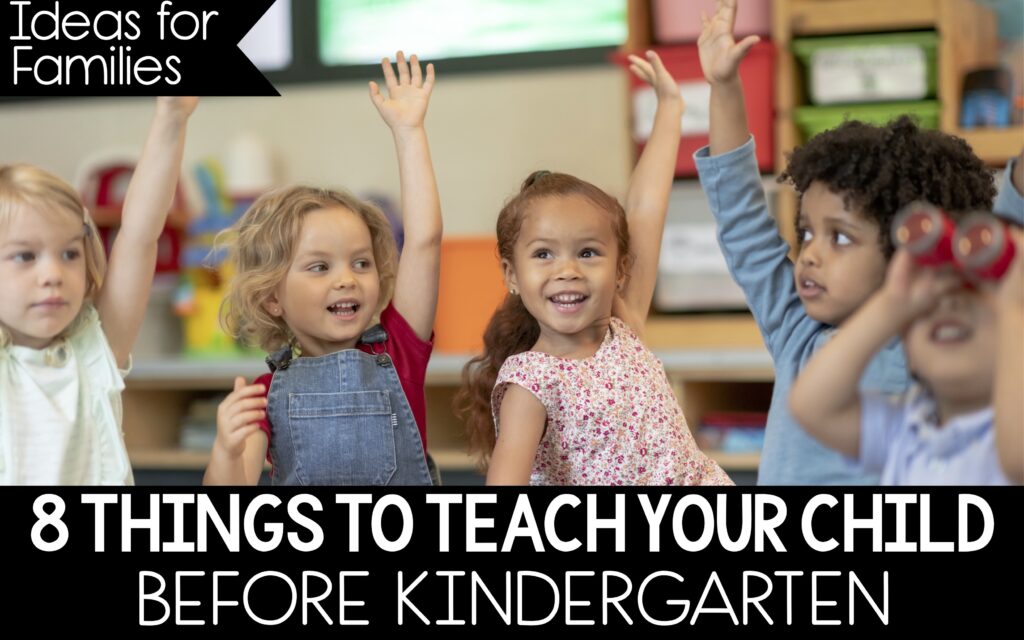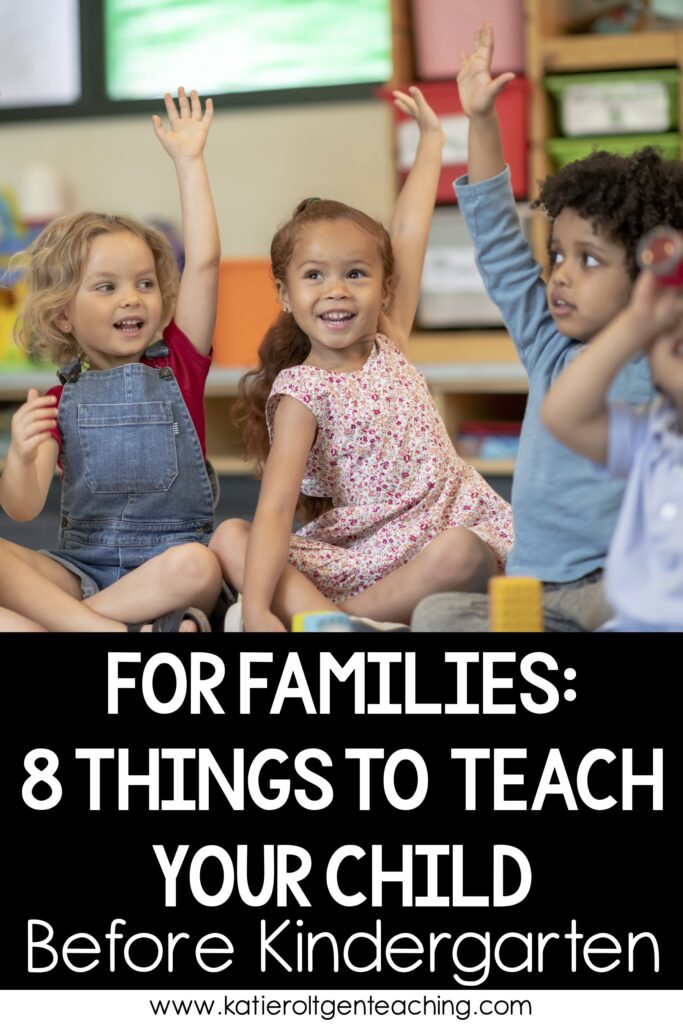
Menu
As any kindergarten teacher will tell you, one of the best parts of the kindergarten year is seeing each child’s growth throughout the year. The academic growth is always exciting, but it’s just as (if not more) exciting to watch kindergarteners grow in their confidence, relationships with peers, and maturity.

Another thing that any kindergarten teacher will tell you is that, although we meet and accept every child where they are, there are some things that families can do that will help their child get the best start to kindergarten possible.
Rest assured, we spend a lot of time at the beginning of the year going through routines, school expectations, etc. However, giving your child a head start on these eight particular areas will be to their benefit!
Of course, your child’s teacher will teach the playground rules and remind children throughout the year as needed. However, it’s really helpful for families to take time to teach basic rules about playing on a playground with other children.
Here are a few rules that you can discuss and practice with your child:
Teaching your child how to use the restroom is a normal part of their early years. As you know, it’s really important to establish good restroom use at home, such as taking the time to flush and wash their hands well.
Another tip is to teach them how to use a bathroom stall. Try taking a restroom break with them while you’re out and about, such as at a restaurant or store. (If your kids are anything like mine, you probably have LOTS of opportunities to practice when you’re running errands! 😅) Knowing how to lock and unlock a bathroom stall is empowering and important for their privacy and confidence!
This one seems a bit obvious, but it goes beyond shirts and pants. If you live in a place where the weather gets cold, can your child zip his or her coat? Can they put on a hat and mittens?
Be sure your child wears shoes that have a Velcro strap if they cannot tie shoelaces yet. Some teachers and schools might practice that skill during the school day, but don’t rely on your child learning it at school.
Practicing your child’s name seems vague, and that’s intentional on my part. Some children enter kindergarten able to write their name. Others aren’t ready yet or are somewhere in between, but your child’s teacher will be prepared for them either way.
With my own children, my oldest wanted to learn how to write her name very young and did it well by age three. My second, on the other hand, had zero interest until she started preschool. Each child is different! If your child wants to write their name at home, encourage it and make it fun!
Recognizing their name (and the letters and sounds in it) is a big step toward spelling it. Consider labeling things around the house with their name, such as:
Seeing their name around the house is an easy way to help children begin recognizing it. Environmental print, as we call it in the educational world, means text that we see in the world around us. Your child may already recognize signs and symbols around town (hello, McDonald’s arches!), so try to make seeing their name a normal part of their day!
Asking for help can be really intimidating for some children, and that’s an understatement. Personally, I was a shy child who would prefer to sit in silence instead of asking for help. Your child might be able to ask for help or get help at home, but make a point to practice asking, even if it seems silly!
For example, if you see your child struggling with something, it’s easy to jump in and do it for them or offer to help. I’d suggest waiting when you know your child needs help to see if they ask for help. Practice saying the words, “I need help” or “Can you please help me?” at home.
Also, be sure to tell your child that his or her teacher is there to help them, but sometimes the teacher might not see that they need help. That’s why it’s important to practice speaking up!
A great way to empower your child is to talk about how they get to and from school. I’d suggest talking about it a lot! This gives your child a sense of security and confidence. Remind them who picks them up, which bus number they ride, and so on.
It seems cliche for a teacher to tell families to read with their child, but there truly is so much to be said about it. Research has proven over and over again that reading at home has lifelong benefits for children.
You can find books at thrift stores and garage sales, or perhaps you have a little free library in your neighborhood where people take and leave books. The library is obviously a great place to get books to read with your child as well!
I know it’s hard to find time with our busy schedules these days, but adding a couple books at bedtime is a natural and enjoyable way to read more with your child. You can also read during car trips if you’re not driving, or while you’re waiting at a doctor appointment.
This is my final point and it’s a big one. Inevitably, there will be a time when a conflict arises, whether it’s with a school staff member or a school decision. It’s critical that when you’re speaking about school in front of your child, you speak positively. Have adult conversations with other adults and talk to teachers and staff members privately.
Talk about the great things about school with your child. Remind them that their teacher loves them and will take good care of them. Ask questions about school and do your best to frame these discussions in a positive way.
Your child’s teacher has chosen to be there for your child and has spent hundreds of hours preparing and learning in order to make the school year the best that it can be. He or she wants your child to succeed and grow, and you are a huge part of that! By helping teach your child in these eight areas, you’ll be contributing to your child’s education in outstanding ways.
Have a great school year!
